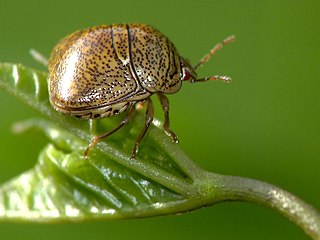See also
| This disambiguation page lists articles associated with the same abbreviated species scientific name. If an internal link led you here, you may wish to change the link to point directly to the intended article. |
P. prasina may refer to:
Paramantis prasina is a praying mantis species in the genus Paramantis.
| This disambiguation page lists articles associated with the same abbreviated species scientific name. If an internal link led you here, you may wish to change the link to point directly to the intended article. |

The Pentatomoidea are a superfamily of insects in the Heteroptera suborder of the Hemiptera order. They are commonly referred to as shield bugs, chust bugs, and stink bugs. As Hemiptera, they share a common arrangement of sucking mouthparts.

Pentatomidae are a family of insects belonging to the order Hemiptera, which are generally called stink bugs or shield bugs. The name Pentatomidae is from the Greek pente meaning five and tomos meaning section, which refers to the five segments of their antennae.

Scutelleridae is a family of true bugs. They are commonly known as jewel bugs or metallic shield bugs due to their often brilliant coloration. They are also known as shield-backed bugs due to the enlargement of the thoracic scutellum into a continuous shield over the abdomen and wings. This latter characteristic distinguishes them from most other families within Heteroptera, and may lead to misidentification as a beetle rather than a bug. These insects feed on plant juices from a variety of different species, including some commercial crops. Closely related to stink bugs, they may also produce an offensive odour when disturbed. There are around 450 species worldwide.

Ahaetulla prasina is a species of snake in the family Colubridae native to southern Asia. Its common names include Asian vine snake, Boie's whip snake, Gunther's whip snake, and Oriental whip snake.

Ahaetulla is a genus of colubrid snakes commonly referred to as vine snakes, or whip snakes. They are considered by some scientists to be mildly venomous and are what is commonly termed as 'rear-fanged' or more appropriately, opisthoglyphous, meaning their enlarged teeth or fangs, intended to aid in venom delivery, are located in the back of the upper jaw, instead of in the front as they are in vipers or cobras. As colubrids, Ahaetulla do not possess a true venom gland or a sophisticated venom delivery system. The Duvernoy's gland of this genus, homologous to the venom gland of true venomous snakes, produces a secretion which, though not well studied, is considered not to be medically significant to humans.

Acanthosomatidae is a family of Hemiptera, commonly named "shield bugs," for which Kumar in his 1979 world revision recognized 47 genera; now this number is 55 genera, with about 200 species, and is one of the least diversified families within Pentatomoidea.

The green shield bug – Palomena prasina – is a European shield bug species in the family Pentatomidae. The name might equally apply to several other species in the tribe Nezarini, or if referred-to as a "green stink bug", it might more appropriately belong to the larger North American bug, Acrosternum hilare. The adult green shield bug ranges in the colour of their backs from bright green to bronze, without any substantial markings. Green shield bugs are a very common shield bug throughout Europe, including the British Isles, and are found in a large variety of habitats, including gardens. They have been found as far north as 63° N latitude.

The hawthorn shield bug is a common European shield bug. Its chief food is haws, the fruit of the hawthorn tree, but adults can overwinter on a diet of leaves, and individuals can be found on many potential food plants, including pedunculate oak, sessile oak and whitebeam. They may grow up to 17 mm (0.67 in) long, and are camouflaged in shades of green and brown. Like many so-called "stink bugs", they may release unpleasant odours when disturbed.

The green hylia is a monotypic genus widespread in tropical Africa, where it mostly inhabits the understory and mid-stratum of moist forests. It is a canopy insectivore which had been tentatively placed within the family of Cettiidae warblers, but in 2019 its assignment to a new family, the Hyliidae, was strongly supported.

Phasia hemiptera is a fly belonging to the family tachinid.

Aeolochroma is a genus of moths in the family Geometridae described by Prout in 1912.

Paraneoptera is a monophyletic superorder of insects which includes four orders, the bark lice, true lice, thrips, and hemipterans, the true bugs. The mouthparts of the Paraneoptera reflect diverse feeding habits. Basal groups are microbial surface feeders, whereas more advanced groups feed on plant or animal fluids.
A. prasina may refer to:
E. prasina may refer to:

Plataspidae are a family of shield bugs native to the Old World. One species, Megacopta cribraria, has recently become introduced and established in the southeastern United States, where it is a pest of soybeans.

Piezodorus lituratus, the gorse shield bug, is a species of Pentatomidae, a family of shield bugs.

Palomena is a genus of shield bugs of the family Pentatomidae and tribe Nezarini; species are found in Europe and Asia.
Anthaxia prasina is a species of metallic wood-boring beetle in the family Buprestidae. It is found in North America.
Chrysobothris prasina is a species of metallic wood-boring beetle in the family Buprestidae. It is found in North America.